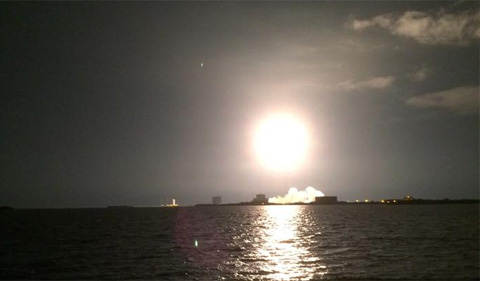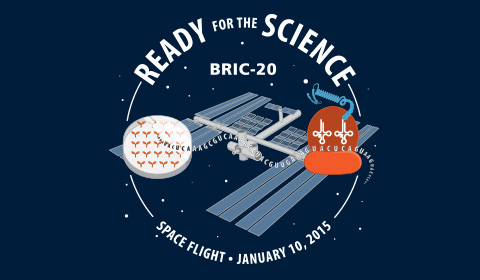Before dawn on Saturday, the SpaceX Falcon 9 carrying an Ohio University experiment finally headed to space after several weeks of launch delay.
Ohio University’s Team Gravitron plants-and-gravity experiment launched Jan. 10 and docks with the International Space Station today, Jan. 12.
Dr. Sarah Wyatt, Professor of Environmental & Plant Biology and principle investigator on the project, was at Kennedy preparing the canisters that will fly as well as the ground control experiment at Kennedy.
Follow the step-by-step at the Wyatt Lab Facebook.
Spot the Space Station
The International Space Station is the third brightest object in the night sky and can be easily seen with the naked eye. To know when to look up to spot the station based at your location, sign up for alerts from NASA here: http://spotthestation.nasa.gov/.
How Do Plants Know Which Way is Up?
Gravity. Not the sun. Plants do not grow “up” because they are attracted to sunlight. They grow up because they are responding to gravity.
On the International Space Station, Wyatt’s Arabidopsis thaliana seeds will germinate and grow in the dark. A control lab at Kennedy will mirror the space conditions—with gravity as the only variable. (Plus two ground controls at OHIO.)
When seedlings germinate in the soil, gravitational signaling tells them which way to grow, and it was that gravitropic signaling that Wyatt began exploring about 15 years ago. At that time, scientists knew almost nothing about how plants “signaled” gravity. Now hers is one of only a few labs in the world—including one in Wisconsin and one in Japan—studying how plants respond to gravity.
Space Flight Experiment Schedule
- Jan. 8: Wyatt and graduate student Proma Basu were at Kennedy Space Life Sciences Laboratory preparing the seeds for launch. BRIC 20 (NASA’s biological research in canister). BRIC 20 will be in cold storage until 3 p.m on Sunday to prevent germination. (4 canisters, 22 petri dishes, more than 12,000 seeds are flying.)
- Dec. 9: The samples for BRIC 20 are integrated into the hardware, the Petri Dish Fixation Unit (PDFU) and then placed in a cold bag. (Temperature (4 C). This is known as “integrating the science.”
- Jan. 10: Launch of SpaceX Commercial Supply Services Flight with Cloud-Aerosol Transport System (SpaceX CRS-5) from Cape Canaveral Air Force Station, Florida. SpaceX CRS-5 will deliver cargo and crew supplies to the International Space Station, as well as Team Gravitron’s Arabidopsis thaliana seeds.
- Jan. 12: Dock with International Space Station. Astronauts remove BRIC 20 from the cold bag. Seeds will then germinate, and the seedlings will grow for three days.
- Jan. 16: Astronauts will accuate fixative to stop plant growth.
- Jan. 17: BRIC 20 placed into freezer (-80 C)
- Feb. 17: Return and landing
- Feb. 22: Deintegration of the science. BRIC 20 will be shipped to Ohio University.
- Feb. 23: Arrival of BRIC 20 to Ohio University, Athens, OH.
Team Gravitron
Kennedy Space Center Team
- Dr. Sarah Wyatt, Principle Investigator and Professor of Environmental & Plant Biology at Ohio University
- Dr. Darren Luesse, Principle Investigator and Associate Professor of Biological Sciences at Southern Illinois University Edwardsville.
- Proma Basu, M.S. in Plant Biology student at Ohio University
- Marilyn Hayden, M.S. in Plant Biology student at Ohio University
- Sarah Hutchinson, M.S. in Biological Sciences at SIUE
Ground Team at Ohio University (undergraduates).
They Athens team did a celebratory launch of a SpaceX replica on Dec. 16, the original launch window, taking the opportunity to explain the experiment to those who came in the rain to watch the model launch.
- Colin Kruse – Mission control
- Adam Cook – Model rocket specialist
- Zak Hall – Payload specialist (seed he grew and collected will actually be flown to International Space Station and we will have a small payload on the model)
- Megan Osika – Payload support
Hall grew and collected the seeds that are flying, and he has been to Kennedy during pre-flight preparation.
Kruse preparing two ground control BRICs at the Wyatt Lab on Saturday, Jan. 10. OHIO coffee mugs serve as the simulated BRICs in Athens, and another ground control is under way at Kennedy. The ground controls will be time delayed in order to simulate the temperature and conditions on the space station.






















Comments